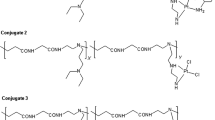Abstract
Organometallic complexes conjugated to cell-penetrating peptides (CPPs) are promising systems for diagnostic imaging and therapeutic applications in human medicine. Recently, we reported on the synthesis of cymantrene(CpMn(CO)3)–CPP conjugates with biological activity on different cancer cell lines. However, the precise mechanism of cytotoxicity remained elusive in these studies. To investigate the role of the metal center and the linker between the CpM(CO)3 moiety and the peptide, a number of derivatives with manganese replaced by rhenium and the keto linker originally used substituted by a methylene group were prepared and fully characterized by 1H NMR spectroscopy, infrared spectroscopy, electrospray ionization mass spectrometry, and elemental analysis as well as X-ray structure determination. The organometal–peptide conjugates as well as carboxyfluorescein-labeled derivatives thereof were prepared by solid-phase peptide synthesis, purified by high-performance liquid chromatography, and analyzed by mass spectrometry. Fluorescence microscopy studies of MCF-7 human breast cancer cells revealed an efficient cellular uptake and pronounced nuclear localization of the bioconjugates with the methylene linker compared with systems with the keto group. In addition, the latter also showed a higher cytotoxicity. In contrast, the variation of the metal center from manganese to rhenium had a negligible effect. The structure–activity relationships determined in the present work will aid in the further tuning of the biological activity of organometal–peptide conjugates.








Similar content being viewed by others
Abbreviations
- ATR:
-
Attenuated total reflection
- CF:
-
5(6)-Carboxyfluorescein
- CPP:
-
Cell-penetrating peptide
- Cym2:
-
Cyclopentadien-1-yl-(3-carboxylato-1-oxopropyl) manganese tricarbonyl
- Cym2*:
-
Cyclopentadien-1-yl-(3-carboxylatopropyl) manganese tricarbonyl
- Cyr2:
-
Cyclopentadien-1-yl-(3-carboxylato-1-oxopropyl) rhenium tricarbonyl
- Cyr2*:
-
Cyclopentadien-1-yl-(3-carboxylatopropyl) rhenium tricarbonyl
- DCM:
-
Dichloromethane
- DIEA:
-
N,N-Diisopropylethylamine
- DMF:
-
N,N-Dimethylformamide
- ESI:
-
Electrospray ionization
- Fmoc:
-
Fluorenylmethyloxycarbonyl
- HATU:
-
2-(7-Aza-1H-benzotriazole-1-yl)-1,1,3,3-tetramethyluronium hexafluorophosphate
- HPLC:
-
High-performance liquid chromatography
- IR:
-
Infrared
- LDH:
-
Lactate dehydrogenase
- MALDI:
-
Matrix-assisted laser desorption ionization
- MS:
-
Mass spectrometry
- RP:
-
Reversed phase
- TFA:
-
Trifluoroacetic acid
- ToF:
-
Time of flight
References
Hartinger CG, Dyson PJ (2009) Chem Soc Rev 38:391–401
Melchart M, Sadler PJ (2006) In: Jaouen G (ed) Bioorganometallics. Wiley-VCH, Weinheim, pp 39–64
Strohfeldt K, Tacke M (2008) Chem Soc Rev 37:1174–1187
Todd RC, Lippard SJ (2009) Metallomics 1:280–291
Brooks H, Lebleu B, Vives E (2005) Adv Drug Deliv Rev 57:559–577
Fischer R, Fotin-Mleczek M, Hufnagel H, Brock R (2005) ChemBioChem 6:2126–2142
Turner JJ, Ivanova GD, Verbeure B, Williams D, Arzumanov AA, Abes S, Lebleu B, Gait MJ (2005) Nucleic Acids Res 33:6837–6849
Delehanty JB, Medintz IL, Pons T, Brunel FM, Dawson PE, Mattoussi H (2006) Bioconjug Chem 17:920–927
Lebleu B, Moulton HM, Abes R, Ivanova GD, Abes S, Stein DA, Iversen PL, Arzumanov AA, Gait MJ (2008) Adv Drug Deliv Rev 60:517–529
Schwarze SR, Ho A, Vocero-Akbani A, Dowdy SF (1999) Science 285:1569–1572
Langel Ü (2006) Handbook of cell-penetrating peptides. CRC Press, Boca Raton
Joliot A, Prochiantz A (2004) Nat Cell Biol 6:189–196
Mäe M, Langel Ü (2006) Curr Opin Pharmacol 6:509–514
Stewart KM, Horton KL, Kelley SO (2008) Org Biomol Chem 6:2242–2255
Neundorf I, Hoyer J, Splith K, Rennert R, Peindy N’Dongo HW, Schatzschneider U (2008) Chem Commun 5604–5606
Splith K, Neundorf I, Hu W, Peindy N’Dongo HW, Vasylyeva V, Merz K, Schatzschneider U (2010) Dalton Trans 39:2536–2545
Splith K, Hu W, Schatzschneider U, Gust R, Ott I, Onambele LA, Prokop A, Neundorf I (2010) Bioconjug Chem 21:1288–1296
Neundorf I, Rennert R, Hoyer J, Schramm F, Loebner K, Kitanovic I, Woelfl S (2009) Pharmaceuticals 2:49–65
Fulmer GR, Miller AJM, Sherden NH, Gottlieb HE, Nudelman A, Stoltz BM, Bercaw JE, Goldberg KI (2010) Organometallics 29:2176–2179
Peindy N’Dongo HW, Neundorf I, Merz K, Schatzschneider U (2008) J Inorg Biochem 102:2114–2119
Fischer R, Mader O, Jung G, Brock R (2003) Bioconjug Chem 14:653–660
Sheldrick GM (1996) SADABS. University of Göttingen
Sheldrick GM (1997) SHELXL-97. University of Göttingen
Peindy N’Dongo HW, Ott I, Gust R, Schatzschneider U (2009) J Organomet Chem 694:823–827
Rosita D, DeWit MA, Luyt LG (2009) J Med Chem 52:2196–2203
Bhattacharyya S (1998) J Org Chem 63:7101–7102
Peindy N’Dongo HW, Liu Y, Schmutz P, Spingler B, Alberto R (2009) J Organomet Chem 694:981–987
Fitzpatrick PJ, Le Page Y, Butler IS (1981) Acta Crystallogr Sect B 37:1052–1058
Schaffer P, Gleave JA, Lemon JA, Reid LC, Pacey LK, Farncombe TH, Boreham DR, Zubieta J, Babich JW, Doering LC, Valliant JF (2008) Nucl Med Biol 35:159–169
Policar C, Waern JB, Plamont MA, Clede S, Mayet C, Prazeres R, Ortega JM, Vessieres A, Dazzi A (2011) Angew Chem Int Ed 50:860–864
Uehara T, Koike M, Nakata H, Miyamoto S, Motoishi S, Hashimoto K, Oku N, Nakayama M, Arano Y (2003) Nucl Med Biol 30:327–334
Acknowledgments
This work was supported by the Deutsche Forschungsgemeinschaft within FOR 630 “Biological function of organometallic compounds.” I.N. and U.S. thank Annette Beck-Sickinger (Universität Leipzig) and Nils Metzler-Nolte (Ruhr-Universität Bochum) for generous access to all facilities of the respective institutes.
Author information
Authors and Affiliations
Corresponding author
Rights and permissions
About this article
Cite this article
Hu, W., Splith, K., Neundorf, I. et al. Influence of the metal center and linker on the intracellular distribution and biological activity of organometal–peptide conjugates. J Biol Inorg Chem 17, 175–185 (2012). https://doi.org/10.1007/s00775-011-0840-5
Received:
Accepted:
Published:
Issue Date:
DOI: https://doi.org/10.1007/s00775-011-0840-5




